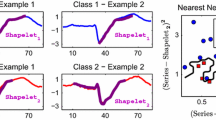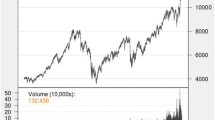Abstract
With the advances in information science, vast amounts of financial time series data can been collected and analyzed. In modern time series analysis, sequential pattern mining (SPM) and association discovery (AD) are the most important techniques to predict the future trends. This study aims at developing advanced SPM and AD for financial data by cutting edge techniques from artificial intelligence and machine learning. The nonlinearity and non-stationarity of financial time series dynamics pose a major challenge for SPM and AD. This study employs time–frequency analysis to extract features for SPM. Then, a sparse multi-manifold clustering (SMMC) is used to partition the feature space into several disjointed regions for better AD. Finally, local relevance vector machines (RVMs) are employed for AD and perform the forecasting. Different from traditional methods, the novel forecasting system operates on multiple resolutions and multiple dynamic regimes. SMMC finds both the neighbors and the weights automatically by a sparse solution, which approximately spans a low-dimensional affine subspace at that point. RVM, the Bayesian kernel machines, can produce parsimonious models with excellent generalization properties. Taking multiple time series data from financial markets as an example, the empirical results demonstrate that the proposed model outperforms traditional models and significantly reduces the forecasting errors. The framework is effective and suitable for other time series forecasting.




















Similar content being viewed by others
Notes
With the possibility that data snooping bias might occur, the statistical difference between model errors can also be measured by White’s reality check (White 2000) to avoid the bias.
References
Atsalakis G, Valavanis K (2009) Surveying stock market forecasting techniques–part II: soft computing methods. Expert Syst Appl 36(3):5932–5941
Atsalakis G, Valavanis K (2010) Surveying stock market forecasting techniques—part I: conventional Methods. J Comput Optim Econ Finance 2(1), Article 4
Bagheri A, Peyhani HM, Akbari M (2014) Financial forecasting using ANFIS networks with quantum-behaved particle swarm optimization. Expert Syst Appl 41(14):6235–6250
Bahrammirzaee A (2010) A comparative survey of artificial intelligence applications in finance: artificial neural networks, expert system and hybrid intelligent systems. Neural Comput Appl 19(8):1165–1195
Bellman RE (2015) Adaptive control processes: a guided tour, vol 2045. Princeton University Press, Princeton
Bengio Y, Simard P, Frasconi P (1994) Learning long-term dependencies with gradient descent is difficult. IEEE Trans Neural Netw 5(2):157–166
Cervelló-Royo R, Guijarro F, Michniuk K (2015) Stock market trading rule based on pattern recognition and technical analysis: forecasting the DJIA index with intraday data. Expert Syst Appl 42(14):5963–5975
Chang PC, Wu JL, Lin JJ (2016) A TakagiVSugeno fuzzy model combined with a support vector regression for stock trading forecasting. Appl Soft Comput 38:831–842
Chatzis SP, Siakoulis V, Petropoulos A, Stavroulakis E, Vlachogiannakis N (2018) Forecasting stock market crisis events using deep and statistical machine learning techniques. Expert Syst Appl 112:353–371
Chen TL, Chen FY (2016) An intelligent pattern recognition model for supporting investment decisions in stock market. Inf Sci 346:261–274
Chen Y, Hao Y (2017) A feature weighted support vector machine and K-nearest neighbor algorithm for stock market indices prediction. Expert Syst Appl 80:340–355
Cheung YL, Cheung YW, Wan AT (2009) A highVlow model of daily stock price ranges. J Forecast 28(2):103–119
Cho K, Van Merriënboer B, Gulcehre C, Bahdanau D, Bougares F, Schwenk H, Bengio Y (2014) Learning phrase representations using RNN encoder–decoder for statistical machine translation. arXiv preprint arXiv:1406.1078
Chong E, Han C, Park FC (2017) Deep learning networks for stock market analysis and prediction: methodology, data representations, and case studies. Expert Syst Appl 83:187–205
Cristianini N, Shawe-Taylor J (2000) An introduction to support vector machines. Cambridge University Press, Cambridge
Elhamifar E, Vidal R (2011) Sparse manifold clustering and embedding. In: Neural information processing systems (NIPS)
Enke D, Mehdiyev N (2013) Stock market prediction using a combination of stepwise regression analysis, differential evolution-based fuzzy clustering, and a fuzzy inference neural network. Intell Autom Soft Comput 19(4):636–648
Fan JH, Akimov A, Roca E (2013) Dynamic hedge ratio estimations in the European Union emissions offset credit market. J Clean Prod 42:254–262
Gençay R, Selçuk F, Whitcher B (2002) An introduction to wavelets and other filtering methods in finance and economics. Academic Press, London
Georgantopoulos AG (2012) Forecasting tourism expenditure and growth: a VAR/VECM analysis for Greece at both aggregated and disaggregated levels. Int Res J Finance Econ 96(105):155–167
Gorgulho A, Neves R, Horta N (2011) Applying a GA Kernel on optimizing technical analysis rules for stock pricing and portfolio composition. Expert Syst Appl 38:14072–14085
Gupta R, Wohar M (2017) Forecasting oil and stock returns with a Qual VAR using over 150 years off data. Energy Econ 62:181–186
Hadavandi E, Shavandi H, Ghanbari A (2010) Integration of genetic fuzzy systems and artificial neural networks for stock price forecasting. Knowl Based Syst 23(8):800–808
Henrique BM, Sobreiro VA, Kimura H (2019) Literature review: machine learning techniques applied to financial market prediction. Expert Syst Appl 124:226–251
Herrera AM, Hu L, Pastor D (2018) Forecasting crude oil price volatility. Int J Forecast 34(4):622–635
Hsieh TJ, Hsiao HF, Yeh WC (2011) Forecasting stock markets using wavelet transforms and recurrent neural networks: an integrated system based on artificial bee colony algorithm. Appl Soft Comput 11(2):2510–2525
Hochreiter S, Schmidhuber J (1997) Long short-term memory. Neural Comput 9(8):1735–1780
Holt CC (2004) Forecasting seasonals and trends by exponentially weighted moving averages. Int J Forecast 20(1):5–10
In F, Kim S (2006) The hedge ratio and the empirical relationship between the stock and futures markets: a new approach using wavelet analysis. J Bus 79:799–820
Kamruzzaman J, Sarker R (2003) Forecasting of currency exchange rate using ANN: a case study. In: Proceedings of IEEE international conference on neural networks and signal processing (ICNNSP’03), Nanjing, China, pp 793–797
Kavussanos MG, Nomikos NK (2000) Hedging in the freight futures market. J Deriv 8(1):41–58
Kavussanos MG, Visvikis ID, Alexakis PD (2008) The lead-lag relationship between cash and stock index futures in a new market. Eur Financ Manag 14(5):1007–1025
Kavussanos MG, Visvikis ID, Dimitrakopoulos D (2010) Information linkages between Panamax freight derivatives and commodity derivatives markets. Marit Econ Log 12(1):91–110
Kim HY, Won CH (2018) Forecasting the volatility of stock price index: a hybrid model integrating LSTM with multiple GARCH-type models. Expert Syst Appl 103:25–37
Krollner B, Vanstone B, Finnie G (2010) Financial time series forecasting with machine learning techniques: a survey. In: European symposium on artificial neural networks: computational and machine learning, Bruges, Belgium
Lee TK, Cho JH, Kwon DS, Sohn SY (2019) Global stock market investment strategies based on financial network indicators using machine learning techniques. Expert Syst Appl 117:228–242
Li Y (2017) Deep reinforcement learning: an overview. arXiv preprint arXiv:1701.07274
Li ST, Kuo SC (2008) Knowledge discovery in financial investment for forecasting and trading strategy through wavelet-based SOM networks. Expert Syst Appl 34(2):935–951
Lillicrap TP, Hunt JJ, Pritzel A, Heess N, Erez T, Tassa Y, Silver D, Wierstra D (2015) Continuous control with deep reinforcement learning. arXiv preprint arXiv:1509.02971
Lin X, Yang Z, Yixu S (2011) Intelligent stock trading system based on improved technical analysis and echo state network. Expert Syst Appl 38(9):11347–11354
Lin T, Guo T, Aberer K (2017) Hybrid neural networks for learning the trend in time series. In: Proceedings of the twenty-sixth international joint conference on artificial intelligence, IJCAI-17, pp 2273–2279
Lipton ZC, Kale DC, Elkan C, Wetzel R (2015) Learning to diagnose with LSTM recurrent neural networks. arXiv preprint arXiv:1511.03677
Malhotra P, Vig L, Shroff G, Agarwal P (2015) Long short term memory networks for anomaly detection in time series. In: Proceedings, Presses universitaires de Louvain
Michell K (2018) A stock market risk forecasting model through integration of switching regime, ANFIS and GARCH techniques. Appl Soft Comput 67:106–116
Morana CA (2010) semiparametric approach to short-term oil price forecasting. Energy Econ 23(3):325–338
Ng AY, Jordan MI, Weiss Y (2002) On spectral clustering: analysis and an algorithm. In: Advances in neural information processing systems, MIT Press, pp 849–852
Nunes M, Gerding E, McGroarty F, Niranjan M (2019) A comparison of multitask and single task learning with artificial neural networks for yield curve forecasting. Expert Syst Appl 119:362–375
Nobre J, Neves RF (2019) Combining principal component analysis, discrete wavelet transform and XGBoost to trade in the financial markets. Expert Syst Appl 125:181–194
Oh SK, Kim MS, Eom TD, Lee JJ (2005) Heterogeneous local model networks for time series prediction. Appl Math Comput 168(1):164–177
Ohlan R (2017) The relationship between tourism, financial development and economic growth in India. Future Bus J 3(1):9–22
Patel J, Shah S, Thakkar P, Kotecha K (2015) Predicting stock market index using fusion of machine learning techniques. Expert Syst Appl 42(4):2162–2172
Podsiadlo M, Rybinski H (2016) Financial time series forecasting using rough sets with time-weighted rule voting. Expert Syst Appl 66:219–233
Qin Y, Song D, Chen H, Cheng W, Jiang G, Cottrell G (2017) A dual-stage attention-based recurrent neural network for time series prediction. arXiv preprint arXiv:1704.02971
Ren Y, Bai G (2010) Determination of optimal SVM parameters by using GA/PSO. J Comput 5(8):1160–1168
Rumelhart DE, Hinton GE, Williams RJ (1988) Learning representations by back-propagating errors. Cognit Model 5(3):1
Schoelkopf B, Burges CJC, Smola AJ (1999) Advances in kernel methods—support vector learning. MIT Press, Cambridge
Song H, Qiu RT, Park J (2019) A review of research on tourism demand forecasting. Ann Tour Res 75:338–362
Sutton RS, Barto AG (1998) Introduction to reinforcement learning. MIT Press, Cambridge
Sutton RS, McAllester DA, Singh SP, Mansour Y (2000) Policy gradient methods for reinforcement learning with function approximation. In: Advances in neural information processing systems, pp 1057–1063
Tang H, Dong P, Shi Y (2019) A new approach of integrating piecewise linear representation and weighted support vector machine for forecasting stock turning points. Appl Soft Comput 78:685–696
Tipping ME (2001) Sparse Bayesian learning and the relevance vector machine. J Mach Learn Res 1:211–244
Van Hasselt H, Guez A, Silver D (2016) Deep reinforcement learning with double q-learning. In: Thirtieth AAAI conference on artificial intelligence
Vapnik VN (1995) The nature of statistical learning theory. Springer, New York
Wang Z, Schaul T, Hessel M, Van Hasselt H, Lanctot M, De Freitas N (2015) Dueling network architectures for deep reinforcement learning. arXiv preprint arXiv:1511.06581
Wasserman PD (1993) Advanced methods in neural computing. Van Nostrand Reinhold, New York, pp 155–61
White H (2000) A reality check for data snooping. Econometrica 68(5):1097–1126
Winters PR (1960) Forecasting sales by exponentially weighted moving averages. Manag Sci 6:324–342
Yang HF, Chen YPP (2019) Hybrid deep learning and empirical mode decomposition model for time series applications. Expert Syst Appl 120:128–138
Zhang BL, Coggins R, Jabri MA, Dersch D, Flower B (2001) Multiresolution forecasting for futures trading using wavelet decompositions. IEEE Trans Neural Netw 12(4):765–775
Author information
Authors and Affiliations
Corresponding author
Ethics declarations
Conflict of interest
This manuscript does not have any potential conflicts of interest (including financial or non-financial).
Additional information
Communicated by Mu-Yen Chen.
Publisher's Note
Springer Nature remains neutral with regard to jurisdictional claims in published maps and institutional affiliations.
Rights and permissions
About this article
Cite this article
Huang, SC., Chiou, CC., Chiang, JT. et al. Online sequential pattern mining and association discovery by advanced artificial intelligence and machine learning techniques. Soft Comput 24, 8021–8039 (2020). https://doi.org/10.1007/s00500-019-04100-5
Published:
Issue Date:
DOI: https://doi.org/10.1007/s00500-019-04100-5




